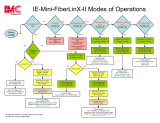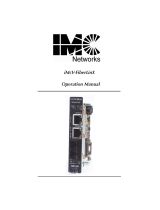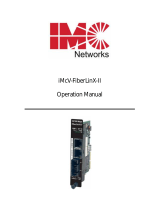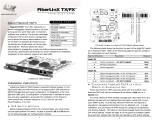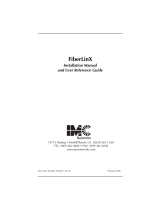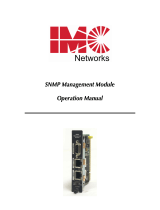Page is loading ...

iMcV-Giga-FiberLinX-II
Operation Manual
Above illustrations are representative; some minor differences may be present in actual product

ii
FCC Radio Frequency Interference Statement
This equipment has been tested and found to comply with the limits for a Class A computing device, pursuant to Part 15 of the FCC Rules.
These limits are designed to provide reasonable protection against harmful interference when the equipment is operated in a commercial
environment. This equipment generates uses and can radiate radio frequency energy and, if not installed and used in accordance with the
instruction manual, may cause harmful interference to radio communications. Operation of this equipment in a residential area is likely to
cause harmful interference in which the user will be required to correct the interference at his own expense.
Any changes or modifications not expressly approved by the manufacturer could void the user’s authority to operate the equipment.
The use of non-shielded I/O cables may not guarantee compliance with FCC RFI limits. This digital apparatus does not exceed the Class A
limits for radio noise emission from digital apparatus set out in the Radio Interference Regulation of the Canadian Department of
Communications.
Le présent appareil numérique n’émet pas de bruits radioélectriques dépassant les limites applicables aux appareils numériques de classe A
prescrites dans le Règlement sur le brouillage radioélectrique publié par le ministère des Communications du Canada.
Warranty
IMC Networks warrants to the original end-user purchaser that this product, EXCLUSIVE OF SOFTWARE, shall be free
from defects in materials and workmanship under normal and proper use in accordance with IMC Networks' instructions
and directions for a period of six (6) years after the original date of purchase. This warranty is subject to the limitations set
forth below.
At its option, IMC Networks will repair or replace at no charge the product which proves to be defective within such
warranty period. This limited warranty shall not apply if the IMC Networks product has been damaged by unreasonable
use, accident, negligence, service or modification by anyone other than an authorized IMC Networks Service Technician
or by any other causes unrelated to defective materials or workmanship. Any replaced or repaired products or parts carry
a ninety (90) day warranty or the remainder of the initial warranty period, whichever is longer.
To receive in-warranty service, the defective product must be received at IMC Networks no later than the end of the
warranty period. The product must be accompanied by proof of purchase, satisfactory to IMC Networks, denoting
product serial number and purchase date, a written description of the defect and a Return Merchandise Authorization
(RMA) number issued by IMC Networks. No products will be accepted by IMC Networks which do not have an RMA
number. For an RMA number, contact IMC Networks at PHONE: (800) 624-1070 (in the U.S and Canada) or (949) 465-
3000 or FAX: (949) 465-3020. The end-user shall return the defective product to IMC Networks, freight, customs and
handling charges prepaid. End-user agrees to accept all liability for loss of or damages to the returned product during
shipment. IMC Networks shall repair or replace the returned product, at its option, and return the repaired or new
product to the end-user, freight prepaid, via method to be determined by IMC Networks. IMC Networks shall not be
liable for any costs of procurement of substitute goods, loss of profits, or any incidental, consequential, and/or special
damages of any kind resulting from a breach of any applicable express or implied warranty, breach of any obligation
arising from breach of warranty, or otherwise with respect to the manufacture and sale of any IMC Networks product,
whether or not IMC Networks has been advised of the possibility of such loss or damage.
EXCEPT FOR THE EXPRESS WARRANTY SET FORTH ABOVE, IMC NETWORKS MAKES NO OTHER WARRANTIES,
WHETHER EXPRESS OR IMPLIED, WITH RESPECT TO THIS IMC NETWORKS PRODUCT, INCLUDING WITHOUT
LIMITATION ANY SOFTWARE ASSOCIATED OR INCLUDED. IMC NETWORKS SHALL DISREGARD AND NOT BE
BOUND BY ANY REPRESENTATIONS OR WARRANTIES MADE BY ANY OTHER PERSON, INCLUDING EMPLOYEES,
DISTRIBUTORS, RESELLERS OR DEALERS OF IMC NETWORKS, WHICH ARE
INCONSISTENT WITH THE WARRANTY SET FORTH ABOVE. ALL IMPLIED WARRANTIES INCLUDING THOSE OF
MERCHANTABILITY AND FITNESS FOR A PARTICULAR PURPOSE ARE HEREBY LIMITED TO THE DURATION OF THE
EXPRESS WARRANTY STATED ABOVE.
Every reasonable effort has been made to ensure that IMC Networks product manuals and promotional materials
accurately describe IMC Networks product specifications and capabilities at the time of publication. However, because of
ongoing improvements and updating of IMC Networks products, IMC Networks cannot guarantee the accuracy of printed
materials after the date of publication and disclaims liability for changes, errors or omissions.

iii
Table of Contents
FCC Radio Frequency Interference Statement ------------------------------------------------- ii
Warranty ----------------------------------------------------------------------------------------------- ii
About the iMcV-Giga-FiberLinX-II ---------------------------------------------------------------- 1
iView
2
Management Software --------------------------------------------------------------------- 4
Installation --------------------------------------------------------------------------------------------- 5
LED Operation ---------------------------------------------------------------------------------------- 6
TX/FX LEDs ----------------------------------------------------------------------------------------- 6
TX/SFP LEDs --------------------------------------------------------------------------------------- 7
SFP/SFP LEDs -------------------------------------------------------------------------------------- 8
Hardware Configuration ---------------------------------------------------------------------------- 9
Software Configuration-----------------------------------------------------------------------------11
FX/TX LinkLoss and FiberAlert --------------------------------------------------------------------13
Using Telnet ------------------------------------------------------------------------------------------17
Basic Device Configuration ------------------------------------------------------------------- 18
Application Overview ------------------------------------------------------------------------------32
Application Examples-------------------------------------------------------------------------------33
Troubleshooting -------------------------------------------------------------------------------------47
Serial Port Pinout ------------------------------------------------------------------------------------49
Modes of Operation --------------------------------------------------------------------------------50
IMC Networks Technical Support----------------------------------------------------------------51
Specifications-----------------------------------------------------------------------------------------52
Standards/Compliance -----------------------------------------------------------------------------53
Fiber Optic Cleaning Guidelines -----------------------------------------------------------------54
Electrostatic Discharge Precautions--------------------------------------------------------------55
Safety Certifications ---------------------------------------------------------------------------------56

1
About the iMcV-Giga-FiberLinX-II
NOTE
Unless noted otherwise, all references to the iMcV-Giga-FiberLinX-II in this manual are also
applicable to the iMcV-Giga-FiberLinX-II TX/SFP and iMcV-Giga-FiberLinX-II SFP/SFP.
Overview
The iMcV-Giga-FiberLinX-II allows network operators to deploy managed Ethernet
services, with a full range of remote management, traffic monitoring, and alarm
reporting features. Operators can choose from enhanced versions combining 1000
Mbps fiber to 10/100/1000 Mbps copper, or an all-copper version. The fiber-to-
copper versions are available for a range of fiber connectors (SC, ST, or SFP) and a
variety of wavelengths, supporting higher density CWDM and single-strand fiber
operation.
The iMcV-Giga-FiberLinX-II supports two main configuration modes: Standalone or
Host/Remote. When using Host/Remote, the Remote modules can be fully managed
without an IP address using a secure management channel. In either mode, the
network operator can choose to assign an IP address to the Host or Standalone
module. Or, if using a local iMediaChassis managed chassis, all local and remotely
connected iMcV-Giga-FiberLinX-II modules can be managed using the single IP
address of the chassis. This not only preserves IP addresses and reduces configuration
complexity, but management traffic traveling on the non-IP based transmission
channel is kept isolated from customer traffic, enhancing network security.
The iMcV-Giga-FiberLinX-II offers the following features:
•
Securely separates the SNMP management network from the data network
•
IEEE 802.1Q VLAN Tagging
•
Q-in-Q VLAN Extra-Tagging with EtherType (TPID) selection
•
Remote traffic monitoring
•
Remote automatic alarms
•
Bandwidth limiting
•
FiberAlert (loss return)—Fiber versions only
•
FX and TX LinkLoss (Link Fault Pass Through (LFPT)
•
Loopback testing
•
Auto Negotiation
•
Selective Advertising
•
AutoCross
•
Broadcast Storm Protection
•
Provisioned for IEEE-802.3ah OAM support
•
Coming soon: ability to be configured as a Remote device and managed through
UMA

2
The iMcV-Giga-FiberLinX-II module is a double-slot, chassis-mounted module.
Compatible chassis include the following:
•
iMediaChassis series
•
MediaChassis series
•
IE-MediaChassis series
Port Interfaces
Every
iMcV-Giga-FiberLinX-II
includes the following port:
•
A 10/100/1000 twisted pair port (EXT MGMT) for management
One of the following uplink ports:
• One fixed 1000 Mbps Fiber port
• A SFP port capable of receiving a gigabit fiber optic SFP module or a
gigabit twisted pair (RJ-45) SFP module
And one of the following DATA ports:
•
A 10/100/1000 twisted pair (RJ-45) port
•
A SFP port capable of receiving a gigabit fiber optic SFP module or a gigabit
twisted pair (RJ-45) SFP module
Configure the iMcV-Giga-FiberLinX-II by using either the serial craft port connection,
through SNMP management application such as iView² or a Telnet session.
About Serial Port Configuration
The iMcV-Giga-FiberLinX-II includes a serial port on the unused pins of the EXT
MGMT Ethernet port. This RS-232 serial connection provides access to the iMcV-
Giga-FiberLinX-II module configuration screens. These configuration screens are also
accessible from a Telnet connection.
DHCP Disable (Static IP Addressing)
DHCP is disabled in the default configuration. Initially, modules are assigned a Static
default IP Address of 10.10.10.10. Changes to the Static IP Address can be added
manually through iConfig, an RS-232 Serial session, or Telnet. The changes will be
initiated following reboot of the module.
DHCP Enable (Dynamic IP Addressing)
If a DHCP server is present on the network and DHCP is enabled, the DHCP client
will initiate a dialogue with the server during the boot up sequence. The server will
then issue an IP address to the management card. Once the new IP address is
received, the SNMP Management Module will reboot so that the new IP address will

3
take effect. Refer to About Serial Port Configuration for more information about
Enabling/Disabling DHCP.
When there is no DHCP server on the network, use iConfig or serial configuration to
manually set the IP addresses.
When DHCP is enabled, the IP address (default 10.10.10.10 or user configured) is
saved. When DHCP is disabled, the saved IP address will be reinstated and the
device will reboot.
DHCP servers give out lease times: devices renew their leases based on the
administrator-specified time. If a device cannot renew its lease, and the lease expires,
the device will be given the IP address 10.10.10.10 and will reboot.

4
iView
2
Management Software
iView² is the IMC Networks management software designed specifically for the IMC
Networks iMcV family of modules. It features a Graphical User Interface (GUI) and
gives network managers the ability to monitor and control the manageable IMC
Networks products.
iView
2
is available in several versions and can also function as a snap-in module for
HP OpenView Network Node Manager. For assistance in selecting the right version
of iView² for a specific operating system, please visit:
http://www.imcnetworks.com/products/iview2.cfm
iView
2
supports the following platforms:
•
Windows NT
•
Windows 2000
•
Windows XP
•
Windows Vista
In addition, there are Java versions of iView² for other Java capable operating systems
such as Linux.
iConfig Utility
iConfig is a configuration utility in iView² that allows the user to quickly and easily
complete the initial SNMP configuration for IMC Networks’ SNMP-manageable
devices. iConfig can set the IP address, set the Subnet Mask and Default Gateway,
define the Community Strings, and define SNMP Traps. iConfig can also be used to
upload new versions of unit software.
iConfig offers an authorized IP address system and access restriction to MIB groups
supported by the IMC Networks manageable devices. These extra layers of security
are purely optional and do not effect SNMP compatibility in any way.
Default Username/Password
The default user ID and password for both iConfig and Telnet are the following:
User: admin
/
Password: admin
For information on how to set/change passwords, see
Password Protection/Changing
Password
.
NOTE
It is the responsibility of the network administrator to store and maintain the
password lists.

5
Installation
Each iMcV-Giga-FiberLinX-II module requires two slots in an iMediaChassis,
MediaChassis or IE-MediaChassis. To install the module in a chassis, remove the
blank faceplates covering the slots where the module is to be installed. Then slide
the module into the chassis card guides until the module is seated securely in the
connector. Secure the module to the chassis by tightening the captive screw.
The iMcV-Giga-FiberLinX-II module includes on-board SNMP logic. A chassis other
than an iMediaChassis series cannot manage an iMcV-Giga-FiberLinX-II, so the iMcV-
Giga-FiberLinX-II must be managed independently.
When installed in an iMediaChassis, the iMcV-Giga-FiberLinX-II module can be
managed from the chassis by using the Unified Management Agent (UMA). Refer to
http://www.imcnetworks.com/Products/Unified_Management_Agent.cfm
for more
information on using UMA with iConfig, iMediaChassis and iMcV-Giga-FiberLinX-II.
iMcV-Giga-FiberLinX-II modules not managed by UMA must have an IP address
assigned to them after installation before they can be managed. Refer to
Assigning IP
Information
for more information.
Small Form-Factor Pluggable Ports (SFP)
iMcV-Giga-FiberLinX-II modules are available with one or two optional SFP port(s). It
is necessary to use a 1000 Mbps speed SFP for fiber connections or any gigabit
copper SFP (1000 Mbps or 10/100/1000 Mbps). In addition, many SFPs, including
those from IMC Networks, feature enhanced diagnostics capabilities with a Digital
Diagnostics Monitoring Interface (DDMI). DDMI statistics provide real-time access to
transceiver operating parameters such as voltage, temperature, laser bias current, and
both transmitted and received optical power. DDMI information can be accessed in
iView
2
by clicking
Tables
>
SFP Info
.
NOTE
iMcV-Giga-FiberLinX-II has been tested with the IMC Networks SFP modules. You can install
any MSA-compliant SFP module. However, IMC Networks does not guarantee the
functionality of non-IMC Networks SFP modules due to possible non-conformity with MSA
design standards.
AutoCross Feature for Twisted Pair Connection
All twisted pair ports on the iMcV-Giga-FiberLinX-II include AutoCross, a feature that
automatically selects between a crossover workstation and a straight-through
connection depending on the connected device.

6
LED Operation
iMcV-Giga-FiberLinX-II features diagnostic LEDs as shown below.
TX/FX LEDs
FDX/COL:
•
Glows yellow when port is operating in Full-Duplex.
•
Blinks yellow when collisions occur on port.
LNK/ACT:
•
Glows green when link is established on port.
•
Blinks green during data activity on port.
Diagnostic LEDs
FCU (Far CPU Up):
•
Host: Glows green
when far end is
detected.
•
Remote: Glows green
when unit is
configured as Remote.
•
Standalone Unit: LED
remains OFF.
SNMP:
This LED glows green to
indicate that this is an
SNMP manageable module.
EXT 1000:
Glows green when EXT
MGMT port is operating at
1000 Mbps.
DATA 1000:
Glows yellow when DATA
port is operating at 1000
Mbps.
Optics Port LEDs
FA:
Glows green when FiberAlert is
enabled.
FTL (Far TX Link):
•
Host: Glows green when a
link is established on
remote (far-end) DATA
port.
•
Remote: Glows green when
unit is configured as
Remote.
•
Standalone: LED remains
OFF.
LNK/ACT (Link/Activity):
•
Glows green when link is
established on port.
•
Blinks green during data
activity on port.
FDX/COL (Full
Duplex/Collision):
•
Glows yellow when port is
operating in Full-Duplex.
•
Blinks yellow when
collisions occur on port.

7
TX/SFP LEDs
LNK/ACT:
•
Glows green when link is established on port.
•
Blinks green during data activity on port.
FDX:
•
Glows yellow when port is operating in Full-Duplex.
•
Blinks yellow when collisions occur on port.
Diagnostic LEDs
FCU (Far CPU Up):
•
Host: Glows green
when far end is
detected.
•
Remote: Glows green
when unit is
configured as
Remote.
•
Standalone Unit:
LED remains OFF.
SNMP:
This LED glows green to
indicate that this is an
SNMP manageable
module.
EXT 1000:
Glows green when EXT
MGMT port is operating
at 1000 Mbps.
DATA 1000:
Glows yellow when DATA
port is operating at 1000
Mbps.
Optics Port LEDs
FA:
Glows green when FiberAlert
is enabled.
FTL:
•
Host: Glows green
when a link is
established on remote
(far-end) DATA port.
•
Remote: Glows green
when unit is configured
as Remote.
•
Standalone: LED
remains OFF.
LNK/ACT (Link/Activity):
•
Glows green when link
is established on port.
•
Blinks green during data
activity on port.
FDX/COL (Full
Duplex/Collision):
•
Glows yellow when port
is operating in Full-
Duplex.
•
Blinks yellow when
collisions occur on port.

8
SFP/SFP LEDs
LNK/ACT:
•
Glows green when link is established on port.
•
Blinks green during data activity on port.
FDX:
•
Glows yellow when port is operating in Full-Duplex.
•
Blinks yellow when collisions occur on port.
Diagnostic LEDs
FCU (Far CPU Up):
•
Host: Glows green
when far end is
detected.
•
Remote: Glows green
when unit is
configured as
Remote.
•
Standalone Unit:
LED remains OFF.
SNMP:
This LED glows green to
indicate that this is an
SNMP manageable
module.
EXT 1000:
Glows green when EXT
MGMT port is operating
at 1000 Mbps.
DATA 1000:
Glows yellow when DATA
port is operating at 1000
Mbps.
Optics Port LEDs
FA:
Glows green when FiberAlert
is enabled.
FTL:
•
Host: Glows green
when a link is
established on remote
(far-end) DATA port.
•
Remote: Glows green
when unit is configured
as Remote.
•
Standalone: LED
remains OFF.
LNK/ACT (Link/Activity):
•
Glows green when link
is established on port.
•
Blinks green during data
activity on port.
FDX/COL (Full
Duplex/Collision):
•
Glows yellow when port
is operating in Full-
Duplex.
•
Blinks yellow when
collisions occur on port.

9
Hardware Configuration
Before installing the module in a chassis, there are two features that must be selected
using the DIP switches. These selections are:
•
Enable or disable management on each port
(DIP switches 1, 2, and 3)
•
Configure the module as a standalone, a host, or a remote
(DIP switches 7 and 8)
DIP Switch Settings
Before installing the iMcV-Giga-FiberLinX-II, use the DIP Switches to set the
hardware-configurable features. The DIP Switches are located on switch SW1 on the
iMcV-Giga-FiberLinX-II card. Refer to the diagram and table for switch settings and
available features.
Switch Function Default Setting
1
Management on EXT MGMT port ON
2
Management on DATA port
OFF
3
Management on OPTICS or
UPLINK port
OFF
4
Factory use - Do not change
---
5
Factory use - Do not change
---
6
Factory use - Do not change
---
7
Remote Module OFF
8
Host Module OFF
9
Factory use - Do not change
---
0
Factory use - Do not change
---
Host/Remote and Standalone Units
The iMcV-Giga-FiberLinX-II can be used as a Host, Remote, or Standalone unit.
Refer to the
Application Examples
section for examples.
When two iMcV-Giga-FiberLinX-II units are used as a pair, configure one as a Host
unit (DIP switch 8 = ON) and the other as a Remote unit (DIP switch 7 = ON). As a
host unit, the iMcV-Giga-FiberLinX-II requests management information from the
attached remote unit. It then displays that information, along with its own, when

10
queried by SNMP. As a Remote unit, the iMcV-Giga-FiberLinX-II will respond to
requests for management information from an attached Host unit.
The iMcV-Giga-FiberLinX-II default configuration is as a Standalone unit (DIP
Switches 7 and 8 = OFF).
Management
Although the iMcV-Giga-FiberLinX-II provides a twisted pair port solely for
management (EXT MGMT), the iMcV-Giga-FiberLinX-II can be configured to accept
IP-based management traffic from any of its three ports. Enable management on
more than one port, or disable management on all of the ports, as desired. These
switches limit only IP-based management. Host-to- Remote management is IP-less
and is never blocked from the fiber port. Serial port management of the unit is
always available on the EXT MGMT port regardless of the DIP Switch settings.
In addition to defining which ports are used to manage the iMcV-Giga-FiberLinX-II
units, the management DIP Switch settings also define what ports the flow of the
Network Provider’s Management Domain traffic can take through the unit. See
Application Examples
for information regarding the Management Domain.
DIP Switch 1 = On for management on the EXT MGMT port.
DIP Switch 2 = On for management on the DATA port.
DIP Switch 3 = On for management on the OPTICS or UPLINK port.

11
Software Configuration
The following sections describe the features that can be configured. Refer to the
iView² online help for iMcV-Giga-FiberLinX-II module configuration information.
Assigning IP Information
When the iMcV-Giga-FiberLinX-II is installed in an iMediaChassis, use UMA to
manage the iMcV-Giga-FiberLinX-II without an IP address (refer to the iView² online
help for more information on UMA). When the iMcV-Giga-FiberLinX-II is not
installed in an iMediaChassis, SNMP-management is not accessible until the iMcV-
Giga-FiberLinX-II IP information (e.g., IP address, subnet mask, etc.) is configured
(using iConfig, a serial port craft connection, or DHCP). After assigning iMcV-Giga-
FiberLinX-II an IP address, use iView² or another SNMP-compatible Network
Management System (NMS) to remotely configure, monitor and manage the iMcV-
Giga-FiberLinX-II.
Auto Negotiation, Duplex Mode, and Speed
The DATA and EXT MGMT ports on the iMcV-Giga-FiberLinX-II module Auto
Negotiate for speed and duplex mode. This module also provides the option of
selectively advertising or forcing the speed and duplex mode.
Auto Negotiation
The iMcV-Giga-FiberLinX-II ships from the factory with Auto Negotiation enabled on
the twisted-pair ports. In this mode, the ports negotiate for speed and duplex.
Forcing the Speed and Duplex Mode
Manually set the twisted-pair ports on the iMcV-Giga-FiberLinX-II for 10 Mbps or
100, or 1000 Mbps operation at Half- or Full-Duplex (i.e., 10 Mbps Full-Duplex, 10
Mbps Half-Duplex, 100 Mbps Full-Duplex, 100 Mbps Half-Duplex, 1000 Mbps Full-
Duplex, 1000 Mbps Half-Duplex). The Optics Port operates at 1000Mbps Full-
Duplex.
Selective Advertising
Selective Advertising, when used in combination with Auto Negotiation, advertises
only the configured speed and duplex mode for the twisted pair port. If a specific
speed and/or duplex mode are desired, IMC Networks recommends using Selective
Advertising, rather than Force Mode, when connecting to devices that only use Auto
Negotiation.

12
Bandwidth Control
The iMcV-Giga-FiberLinX-II includes bi-directional bandwidth control in 32 Kbps
increments (configurable via iView
2
). This allows the bandwidth limit to be set
independently from the DATA Port to the OPTICS (or UPLINK) Port and vice versa in
a single iMcV-Giga-FiberLinX-II application. In a dual iMcV-Giga-FiberLinX-II
application, it can be set from the Host unit to the Remote unit and vice versa (i.e.,
the bandwidth on the DATA ports on both the Host and Remote modules can be
limited independently).
NOTE
Management packets do not have priority over data packets.

13
FX/TX LinkLoss and FiberAlert
During normal operation, link integrity pulses are transmitted by all point-to-point
Ethernet devices. When an iMcV-Giga-FiberLinX-II receives valid link pulses, it
knows that the device to which it is connected is up, and that the copper or fiber
cable coming from that device is intact. The appropriate LNK (link) LED is lit to
indicate this. For troubleshooting information utilizing the LinkLoss and FiberAlert
features of the iMcV-Giga-FiberLinX-II modules, refer to
Troubleshooting
at the end of
this manual.
** WARNING **
FiberAlert and LinkLoss features cause data interruptions designed to alert remote sites of line
failures. These data interruptions can be misinterpreted as module failures when these features
are enabled. Enable these features only when the resulting data interruptions and causes are
well understood.
FX LinkLoss
FX LinkLoss is a link integrity monitoring feature that forwards fiber link faults to the
RJ-45 Data port to indicate that a fiber link fault has occurred.
TX LinkLoss
TX LinkLoss is a link integrity monitoring feature that forwards an RJ-45 link fault to
the fiber connected device to indicate that a link fault has occurred.
FiberAlert
FiberAlert minimizes the problems associated with the loss of one strand of fiber.
Normally when a single strand of fiber is lost, the transmitting side of the connection
is unaware that there is a fault. FiberAlert returns faults back on the fiber they came
in on.
Using LinkLoss and FiberAlert
In a typical central site to remote site media conversion, it is recommended that the
enable the LinkLoss and FiberAlert features are enabled as indicated in the following:
FiberAlert and LinkLoss
Feature Enabled Fault Location Port affected
FiberAlert
Remote Side Only Fiber Fiber
TX LinkLoss
Remote Side (or both) Twisted Pair Fiber
FX LinkLoss
Host Side (or both) Fiber Twisted Pair
** WARNING **
Do not enable FiberAlert on both modules when using iMcV-Giga-FiberLinX-II in pairs. This

14
will cause them to lock up when a fault occurs on the fiber. Only enable FiberAlert on the
remote module.
Link Fault Pass Through (LFPT)
Link Fault Pass Through is a troubleshooting feature that combines TX and FX
LinkLoss from both the local and remote modules. LFPT is enabled by turning on
both FX and TX LinkLoss on both modules. This feature allows either end of the
conversion to detect a link fault occurring at the other end of the media conversion
chain.
Regardless whether a break occurs on a copper or fiber segment between the End
device and the media converter, or between the two media converters, End devices
at both ends.
Regardless if there is a break in segment 1, 2 or 3, the link will drop on the switches
at both ends.
The link fault is passed through the media conversion and is observed at each end. It
acts just like it would if the devices were directly connected.
NOTE
FiberAlert can also be added to the remote side of the pair to further assist in locating a
fault.
Last Gasp
NOTE
The iMcV-Giga-FiberLinX-II does not support Last Gasp, as the present hardware design
cannot provide that feature.

15
Loopback Testing
The following functions are available during loopback testing. During loopback
testing, management traffic entering the uplink port is still capable of managing the
device. This is selectable form the UNIT screen in a serial/Telnet session. There are
no LoopBack test options in iView²
The menu of choices in the CLI includes:
•
No loopback, normal traffic mode
•
Loopback Enabled
•
Loopback, Source/Destination address swap
•
Loopback, address swap and clear Multicast bit
•
No learning on fiber or Data ports
The menu of choices in iView² includes:
•
Off
•
ON
•
On-Address Swap
•
On-Address Swap + Clear MC
Loopback Testing on Remote or Standalone
No loopback, normal traffic mode
The standard mode in which the units function, either as stand-alone or
Host/Remote.
Loopback Enabled
Loopback mode without address swap
Source/Destination Address Swap
A Layer 2 Ethernet switch will discard all received packets with the same MAC
address as sent packets. To avoid this issue the Loopback feature can swap the source
and destination MAC addresses on the looped data. (This selection can cause a frame
with a multicast source address to be created, which violates the IEEE standard.)
Address Swap and Clear Multicast Bit
In addition to swapping the source and destination MAC addresses on the looped
data, the Loopback feature can also be set to clear the multicast bit. This allows the
looped data to avoid being blocked by any multicast settings.
Loopback Testing in a Host/Remote Configuration
Configure the Host by selecting No Learning on OPTICS and DATA Ports; on the
Remote, choose SRC/DST Address Swap or Address Swap and Clear Multicast Bit.

16
Host: No Learning on OPTICS and DATA Ports
The Loopback feature can be set to disable address learning on the OPTICS (or
UPLINK) and DATA ports, allowing the loopback to be performed without
interference from MAC address filtering functions. This is a function on the HOST
unit. Set the REMOTE unit for Loopback then set the HOST to disable learning so
Loopback frames pass from the Optics port to the Data port.
Remote:Source/Destination Address Swap
A Layer 2 Ethernet switch will discard all received packets with the same MAC
address as sent packets. To avoid this issue the Loopback feature can swap the source
and destination MAC addresses on the looped data.
OR
Address Swap and Clear Multicast Bit
In addition to swapping the source and destination MAC addresses on the looped
data, the Loopback feature can also be set to clear the multicast bit. This allows the
looped data to avoid being blocked by any multicast settings.
NOTE
Units should not be in the Default Mode when performing LoopBack tests.
Broadcast Storm Protection
Broadcast Storm Protection allows setting the maximum broadcast packet rate
allowed as a percentage of line speed (from 0% - 20%). The suggested value is 1%.

17
Using Telnet
It is necessary to assign the iMcV-Giga-FiberLinX-II an IP address before using a Telnet
session (this is not necessary when using UMA). Refer to the
Assigning IP Information
section for more information. All of the configurations that can be performed from
the serial port can also be performed using a Telnet session; only one Telnet session
can be launched at a time.
The following are the three levels for Telnet account access:
User:
View status, change own password, and reboot.
Operator:
All User privileges mentioned above, plus ability to change settings.
Administrator:
Operator privileges mentioned above, plus ability to add/delete
accounts and reinitialize the unit to default settings (cleandb).
Serial Configuration/Telnet Session
The following sections describe serial configuration (including VLAN configuration),
Telnet session configuration, and DHCP configuration.
NOTE
Some screens may show TX and FX for the port titles where TX = DATA port and FX = OPTICS
(or UPLINK) port. The examples are from firmware version 512-00A2.
Serial Port (EXT MGMT)
NOTE
The serial port (EXT MGMT) is always set to Administrator level. The password for Telnet
sessions is the password that is set and used in iConfig (refer to the iConfig section for more
information).
/

